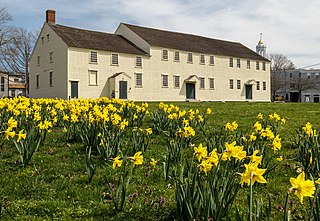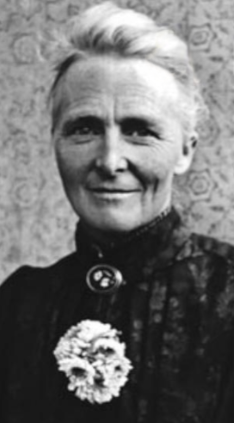Related Research Articles

County Laois is a county in Ireland. It is part of the Eastern and Midland Region and in the province of Leinster. It was known as Queen's County from 1556 to 1922. The modern county takes its name from Loígis, a medieval kingdom. Historically, it has also been known as County Leix.

Rosenallis is a village in north County Laois, Ireland. It is in the foothills of the Slieve Bloom Mountains on the R422 Mountmellick to Birr road.

Mountmellick or Mountmellic is a town in the north of County Laois, Ireland. It lies on the N80 national secondary road and the R422 and R423 regional roads.It is a town within Mountmellick Parish.

The Yearly Meeting of the Religious Society of Friends (Quakers) in Britain, also known as Britain Yearly Meeting, is a Yearly Meeting of the Religious Society of Friends (Quakers) in England, Scotland, Wales, the Channel Islands and the Isle of Man. It is the national organisation of Quakers living in Britain. Britain Yearly Meeting refers to both the religious gathering and the organisation. "Yearly Meeting", or "Yearly Meeting Gathering" are usually the names given to the annual gathering of British Quakers. Quakers in Britain is the name the organisation is commonly known by.

Quakers are people who belong to the Religious Society of Friends, a historically Protestant Christian set of denominations. Members of these movements are generally united by a belief in each human's ability to experience the light within or "answering that of God in every one". Some profess a priesthood of all believers inspired by the First Epistle of Peter. They include those with evangelical, holiness, liberal, and traditional Quaker understandings of Christianity. There are also Nontheist Quakers, whose spiritual practice does not rely on the existence of God. To differing extents, the Friends avoid creeds and hierarchical structures. In 2017, there were an estimated 377,557 adult Quakers, 49% of them in Africa.
The Quaker movement began in England in the 17th Century. Small Quaker groups were planted in various places across Europe during this early period. Quakers in Europe outside Britain and Ireland are not now very numerous although new groups have started in the former Soviet Union and satellite countries. By far the largest national grouping of Quakers in Europe is in Britain.

A Friends meeting house is a meeting house of the Religious Society of Friends (Quakers), where meeting for worship is usually held.

Ballitore is a village in County Kildare, Ireland, sometimes spelt as Ballytore. It is noted for its historical Quaker associations. It was the first planned Quaker village in either England or Ireland - and remains the only one in Europe.
Mary Leadbeater was an Irish Quaker author and diarist who lived most of her life in the planned Quaker settlement of Ballitore, County Kildare. She wrote and published extensively on both secular and religious topics ranging from translation, poetry, letters, children's literature and biography. Her accounts of the Irish Rebellion of 1798 provide an insight into the effects of the Rebellion on the community in Ballitore.

The Friends Burial Ground, also called Temple Hill Burial Ground or the Friends Sleeping Place is a Quaker burial ground located at Temple Hill, Blackrock, Dublin. It opened in 1860 and is one of only two Quaker burial grounds in Dublin; the other being at Cork Street.
WilliamEdmundson or Edmondson (1627—1712) was the founder of Quakerism in Ireland.

Anna Maria Haslam was a suffragist and a major figure in the 19th and early 20th century women's movement in Ireland.
Job Scott was an eminent traveling minister in the Religious Society of Friends and a prominent American quietist. His religious philosophy had a deep, shaping influence that contributed to the first schism in American Quakerism, the 1827 Hicksite-Orthodox split.

Lydia Shackleton was an Irish botanical artist who studied at the Royal Dublin School of Art and Design. She was the first artist-in-residence at the Royal Botanic Gardens in Dublin, creating hundreds of botanic studies. She also taught, wrote verses, and travelled to the United States.
The Religious Society of Friends (Quakers) have a long history in Ireland; their first recorded Meeting for Worship in Ireland was in 1654, at the home of William Edmundson, in Lurgan.

Jane Shackleton was a pioneering Irish photographer. Of the upper-class, she took atypical photographs for her era, focusing on a photojournalistic approach to her subjects, showing the development of Ireland during its period of industrialization.

Eustace Street is a street in the Temple Bar area of Dublin, Ireland.
Samuel Bewley was an Irish businessman, silk merchant and philanthropist. Along with his son Charles, he founded the company Bewley's.
Abraham Shackelton (1696–1771) was a Quaker schoolmaster. Born in West Yorkshire, he settled and established a school in Ballitore, County Kildare, Ireland. His private boarding school, open to people of any faith, educated boys from France, England, and other foreign countries. He taught Edmund Burke, who became a statesman and philosopher, and Paul Cullen, later the Catholic Archbishop of Dublin.
References
- ↑ A Quaker take on Irish Business History by Colm Keena, Irish Times, 2 March 2012.
- ↑ William Penn Cork Past and Present.
- ↑ Quaker Cemetery Rosenallis
- ↑ The Quaker village of Ballitore Irish Quakers, Irish Genealogy Toolkit.
- ↑ Thomas Russell Communist Party of Ireland, Website.
- ↑ Quakers in Ireland Quakers in the World.
- ↑ Quaker burial ground Summer of Heritage Programme.
- ↑ Quakers during the Famine History Ireland
- ↑ "Original text of the constitution of Ireland".
- ↑ "Press Release".
- ↑ "Press Release".
- ↑ "Quaker Historical Library".